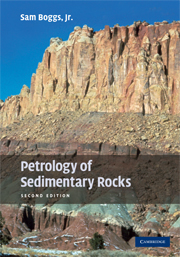Book contents
- Frontmatter
- Contents
- Preface
- Part I Principles
- Part II Siliciclastic sedimentary rocks
- Chapter 2 Sedimentary textures
- Chapter 3 Sedimentary structures
- Chapter 4 Sandstones
- Chapter 5 Conglomerates
- Chapter 6 Mudstones and shales
- Chapter 7 Provenance of siliciclastic sedimentary rocks
- Chapter 8 Diagenesis of sandstones and shales
- Part III Carbonate sedimentary rocks
- Part IV Other chemical/biochemical sedimentary rocks and carbonaceous sedimentary rocks
- References
- Index
- References
Chapter 3 - Sedimentary structures
from Part II - Siliciclastic sedimentary rocks
Published online by Cambridge University Press: 05 June 2012
- Frontmatter
- Contents
- Preface
- Part I Principles
- Part II Siliciclastic sedimentary rocks
- Chapter 2 Sedimentary textures
- Chapter 3 Sedimentary structures
- Chapter 4 Sandstones
- Chapter 5 Conglomerates
- Chapter 6 Mudstones and shales
- Chapter 7 Provenance of siliciclastic sedimentary rocks
- Chapter 8 Diagenesis of sandstones and shales
- Part III Carbonate sedimentary rocks
- Part IV Other chemical/biochemical sedimentary rocks and carbonaceous sedimentary rocks
- References
- Index
- References
Summary
Introduction
Study of sedimentary structures has captured the interest of geologists for decades. Some sedimentary structures such as cross-bedding and ripple marks were recognized as early as the late eighteenth century, and perhaps well before. Progress in identification, description, classification, and interpretation of sedimentary structures has been especially rapid since the 1950s, and the fundamental origin of most sedimentary structures is now reasonably well understood. Nonetheless, empirical study of modern and ancient sediments and experimental investigation of the mechanisms that form sedimentary structures continue. Geologists are especially interested in understanding how specific sedimentary structures are related to such aspects of ancient depositional environments as relative water energy, water depth, and current flow directions. Investigation of the origin and significance of bedforms such as ripples and dunes has been a particularly active field of research.
Many sedimentary structures originate by physical processes involving moving water or wind that operate at the time of deposition. Others are formed by physical processes such as gravity slumping or sediment loading that deform unconsolidated sediment after initial deposition (soft-sediment deformation). Still other structures are of biogenic origin, formed by the burrowing, boring, browsing, or sediment-binding activities of organisms. Some types of bedding, the laminated bedding of evaporites for example, are generated by primary chemical precipitation processes. A few other structures, such as concretions, form by chemical processes operating within sediment during burial and diagenesis; thus, they are regarded to be secondary in origin.
- Type
- Chapter
- Information
- Petrology of Sedimentary Rocks , pp. 63 - 110Publisher: Cambridge University PressPrint publication year: 2009



